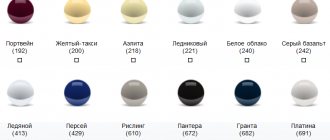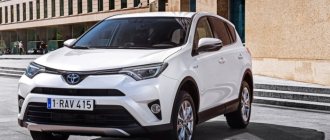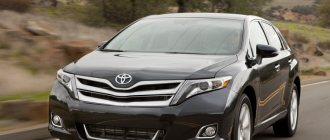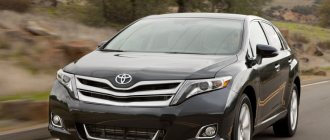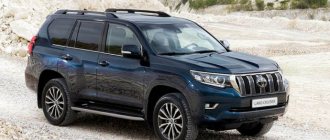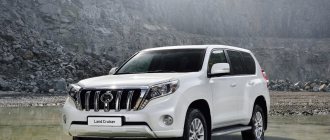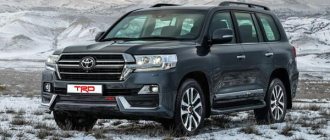The Japanese automaker launched the second generation of its popular SUV, the 2021 Toyota Fortuner, last year. The first show of the model took place last summer, and the date of sale in domestic showrooms was set for the fall. From October 2021, the new Fortuner can be purchased in Russia at a price ranging from 2–2.857 million rubles.
The updated design and a number of other fundamental changes allow us to count on the high popularity of the model - and even now more and more car enthusiasts are interested in how much the car costs, what characteristics and features it has.
Exterior of Toyota Fortuner 2021
In the summer of 2021, a restyling of the second generation of the SUV was presented. The new Toyota Fortuner 2021 has become even more stylish, unusual, and luxurious. This is not just a means of transportation, but also an indicator of the high status of the owner.
The main changes concern the “face” of the car: a new grille on the radiator in chrome, a hood with stylish reliefs, an unusual arrangement of head optics and a harsh front bumper. The color scheme of the new model is restrained: white, black, silver and dark brown. Well-chosen shades are ideally combined with body elements and the overall character of the car.
From the front, the SUV looks like a formidable beast that is eager to attack. This impression is brightened up by clear lateral lines. Wide sills and turn signal repeaters on the mirrors give the exterior an impressive appearance.
Other elements that have been restyled:
- The roof became perfectly level;
- A spoiler appeared above the rear window;
- A chrome molding appeared above the license plate;
- The taillights extended to the fenders;
- The window line rose higher.
It’s almost invisible in the photo, but all the dimensions of the car have increased by several centimeters. The boot looks small but has a capacity of 297 liters with the rear row of seats in place and 620 liters with the seats folded down.
Interior design
Despite the aggressive appearance of the Toyota Fortuner 2021, the interior decoration is made in a calm aristocratic style. All elements are finished in leather, most of the parts are made of hard, high-quality plastic.
The dashboard has three sections:
- Top with deflectors and on-board computer in blue backlight;
- The central one with a touch screen is decorated with aluminum trim;
- The bottom one is for the multimedia and climate control button system.
Toyota Fortuner 2021 in a new body also received new seats. They are designed in a racing style with an anatomical backrest and a wide range of adjustments. There is a three-seater sofa at the back that can be folded if necessary. The third row of seats (there are 2) is hidden in the sides of the trunk.
Particular attention is paid to the quality of materials. The manufacturer has selected plastic that will not begin to creak over time, while at the same time it looks neat and expensive. The center console and steering wheel are covered in eco-leather.
The 2021 Fortuner is positioned as an SUV for businessmen. For the comfort of the driver and passengers, air conditioning, keyless entry, a camera for parking assistance, LED optics, 7 airbags, stabilization and all-wheel drive are installed.
Owner reviews
Almost all reviews from Fortuner 2021 owners are positive and look like this:
- Artem N .: Good optics, comfortable seats, heated steering wheel, spacious interior and trunk (with the last row of seats folded) are quite good advantages of the model, for which it was worth buying it. There are, however, some disadvantages - the right armrest is poorly located and there is no headlight washer.
- Maxim F .: I took the car in April 2021. A month of use showed the following advantages - a powerful diesel engine, excellent cross-country ability, good dynamics for an SUV, acceptable consumption both in the city and on the highway. There are practically no downsides - except that the plastic in the cabin is too soft.
- Sergey M .: I’m choosing Toyota for the umpteenth time. I decided to give preference to Fortuner - I didn’t regret it. The car is enough for the whole large family (5 people) and a decent amount of luggage. There have been no problems in operation so far, there is practically no noise when traveling and it does not matter what road you are driving on.
( 1 ratings, average: 5.00 out of 5)
Technical characteristics of Toyota Fortuner
The second generation of the SUV received new engines. The technical characteristics of the car have improved significantly, and now they correspond to trends in the car market. The new 2.4-liter GD engine runs on diesel fuel and has 150 horses.
It seems that this is not much for such a car, but it is enough to accelerate to hundreds in 14.2 seconds. In the urban cycle, fuel consumption will be 11 liters, on the highway – 8 liters. The engine is equipped with a Common Rail injection system, a turbocharger and a 32-bit controller. Another diesel engine is a 1GD 2.8 liter unit with 177 horses.
Its acceleration dynamics are better – 10 s. Fuel consumption ranges from 9 liters on the highway to 15 liters in the city. The 2.7 liter petrol unit produces 166 hp. It is equipped with 16 valves with variable valve timing. It is equipped with a 6-speed manual or automatic transmission.
The main difference from the first generation is that all-wheel drive does not have a central differential. Rear-wheel drive is permanent; front-wheel drive is connected using an electromechanical system. This can be done even while moving. All trim levels have a locking rear differential.
Reasons for increased fuel consumption
The fuel consumption of the 2021 Toyota Fortuner, like other modifications of this model, is quite modest, especially compared to its classmates. But, according to reviews from some owners, it becomes clear that the passport data for fuel consumption per 100 km does not coincide with real consumption. In the vast majority of cases, the problem lies in the fact that the owner does not adhere to simple rules to reduce this indicator:
- regular maintenance - even the slightest disturbance in the operation of the engine, transmission, electronics or chassis immediately increases consumption;
- calm driving style - it is necessary to avoid sudden accelerations, drive the car smoothly and evenly, this allows you to save up to 20% of fuel;
- timely transition to winter and summer tires – increases safety and reduces fuel consumption;
- warming up the car in the cold season - a cold engine consumes much more fuel;
- using the climate control system, headlights and other electronics only when necessary;
- refueling only with high-quality gasoline or diesel - in addition to saving money, this will extend the life of the engine.
Options and cost
There are 4 trim levels of the Toyota Fortuner 2021, which differ in the set of options and prices.
All trim levels have the following options:
- Road stabilization;
- Help when starting to move on an inclined road;
- Electrically adjustable and heated mirrors;
- Downshift;
- Rain, light and tire pressure sensors.
Russian adaptation of Toyota Fortuner
The Toyota Fortuner 2021 version, which is produced for the Russian market, is slightly different from foreign models. Firstly, all cars are equipped with the ERA-GLONASS system, as required by law.
Secondly, in Russia there is a special winter package that includes heated seats, mirrors and steering wheel, as well as a good stove. Thirdly, the paint and chrome plating is designed to withstand large temperature differences. The manufacturer claims that the enamel will not crack due to cold weather.
All cars are equipped with high-capacity batteries and filled with liquids that do not lose their properties in cold and heat. Front and rear brakes are disc.
Grumpy. Toyota Fortuner SUV test
Over the seven hundred kilometers in the Southern Urals, which I drove in the new Toyota Fortuner SUV, I have seen cars costing more than half a million a few times. And if you consider that the Fortuner costs from 2.6 million rubles, then it lives here mainly in large cities. How suitable is it on asphalt?
Is it a Land Cruiser Prado, only cheaper? After all, after restyling, the price went up by 50-200 thousand rubles - if you, like me, want a version with a rear differential lock, then prepare three million three hundred thousand! And the Fortuner is 700 thousand cheaper. Although both the blocking and the power unit are exactly the same here: a 2.8 turbodiesel (177 hp) and a six-speed automatic transmission.
Moreover, in March next year an anti-crisis Fortuner with a 2.7 petrol engine (163 hp) and simpler equipment will appear in Russia. I hope that the price can be reduced to two million three hundred thousand.
But so far all Fortuners have climate control, a heated steering wheel, seven airbags, and an electric tailgate. There are also a lot of cup holders, two small compartments in the front panel, a convenient slot for a smartphone and an socket for second-row passengers, hooks in the backs of the front seats... It would be nice to add heating for the rear sofa. And there would be more space in the back - after all, the wheelbase here is 45 mm shorter than that of the Prado.
The trunk is unpretentious, although spacious. The wall-hung third-row seats are easy to remove and store in the garage. But there is no underground (instead, a spare tire is attached under the bottom), no curtains. Thanks for the outlet and light.
The tailgate has a slow electric drive, and the compartment itself is simple; there are no separate niches or organizers here. But the volume is decent, the third row seats can be removed using a tool. The interior does not transform into a bed, but it is quite possible to spend the night in nature with the rear seats folded down
I didn't like driving. Yes, you don’t get the usual feeling for frame cars that you’re sitting on the floor, but the chair is a bit rustic, its cushion is a bit short, and it lacks normal lumbar support. The steering wheel is adjustable for reach and height, but the ranges are small. The multimedia system is like the new Corolla, without a single physical button, so it’s easier to control the “music” from the steering wheel. But all the other switches are huge, including the 2H-4H-4L transmission mode dial.
Wait, 2H-4H? Yes, almost the key difference from the Prado is the absence of a center differential. In the Russian office of Toyota, without any hesitation, they allow you to drive with hard-wired all-wheel drive anywhere. But in the meantime, the instructions clearly state that the 4H mode can only be used in conditions that allow wheel slip!
Key keys are located on the central tunnel: selecting powertrain modes, locking the rear differential and turning off the stabilization system
Nevertheless, I took our word for it - and engaged the front end on dry asphalt. Like the Hilux pickup, there is a temperature sensor installed in the front gearbox, and in case of overheating, a warning pictogram will light up on the panel. But for fifty kilometers the oil still did not heat up before the alarm went off. How much extra fuel I spent during this time due to the circulation of power in a rigidly closed all-wheel drive transmission, how this mileage affected the wear of tires and gearboxes are open questions.
And despite the fact that Fortuner is lighter than Prado, subjectively it is even more dynamic. We'll wait for full measurements at the test site, but first estimates show that acceleration to 100 km/h for the diesel Fortuner takes 15 seconds. Horror-horror? No, in the city the Fortuner, although leisurely, is quite predictable, and the six-speed automatic transmission works slowly but softly.
And on the highway, the Fortuner turns into a Grumper: every overtaking takes place to the loud accompaniment of a diesel engine. And you want not only noise, but also traction. However, if you drive at a constant speed and do not raise the tachometer needle above two thousand revolutions, then you will not notice any grumbling.
But diesel fuel consumption cannot be ignored: in total, on asphalt and primers I got 14 l/100 km. Taking into account the 80-liter tank, the power reserve does not exceed 550 kilometers - not enough for a potential expeditioner.
In terms of handling in normal modes, there is no crime: Toyota slowly but adequately responds to steering inputs, rolls as expected and does not create any difficulties. There is even a normal reactive effect. However, in emergency situations, I was surprised by the free adjustment of the stabilization system: if on a Prado or Hilux pickup, when changing lanes sharply, it immediately reduces the speed and sometimes even prevents you from returning to your lane, then there is no intervention in the developing skid! Until you adjust the steering wheel, the electronics are silent.
And if you combine braking with a “detour” maneuver, then the release of the brakes is clearly visible. So in emergency situations on the asphalt, the Fortuner is not the best assistant.
And how to turn off this “massage”? Even on city patches, the Fortuner begins to vigorously shake the floor and seats, vibrations from large wheels are noticeable, the spring rear suspension passes speed bumps more rigidly than the front one, and on the highway the steering column dances to all this. And on the largest asphalt holes with sharp edges, the front suspension works up to the bump stops. Alas, in this Fortuner looks much more like a Mitsubishi Pajero Sport than a comfortable Prado.
By the way, the Fortuner is also related to the Sport by its origin: both are assembled in Thailand mainly for Asian markets. And the Russian one is the frostiest for Fortuner, so cars for our country have different chrome exterior trim, a larger washer reservoir, and a 0.5 kW electric heater is built into the heating system.
Roads in Asia, by the way, are also so-so. But the Fortuner clearly doesn’t like our Russian comb and boldly shares its opinion with passengers: shaking, shock, vibration. In rear-wheel drive, under the supervision of the stabilization system, Toyota often requires steering corrections, and in all-wheel drive mode it is stable - but does not turn very willingly. The car flourishes only on the dirt road: where there are no sharp holes and short waves, it rushes as if on a cushion of air!
Fortuner also loves real off-road driving. Under the metal protection of the engine sump, I measured 225 mm - not bad. The overhangs are neat, the air intake is located in the right wing. “Automatic”, however, does not work optimally when using a lower range: long pauses between shifts make it difficult to accurately dose traction. And keep in mind that instead of an honest manual mode, Toyota traditionally only has ranges. That is, position 3 is not third gear, and all gears are not higher than third.
The engine is covered with a thick metal guard, a small sheet is attached to the transfer case, but the frame cross member in front of it can become an anchor in the rut
Well, the stabilization system imitates cross-wheel locks clearly worse than that of the Mitsubishi: with its help, the Fortuner drives jerkily. Therefore, it is better to immediately activate the mechanical locking of the rear differential, which turns off all assistance systems, including ABS. Then Toyota crawls over difficult terrain with confidence and control. On a steep descent, you can activate a separate assistant - which, unlike other Fortuner electronic assistants, works perfectly: it was very useful on the icy foothills of the Southern Urals.
The travel of the rear dependent suspension is gigantic. When hanging diagonally, the imitation of inter-wheel locks works rough - it is better to use a mechanical rear differential lock
Under the floor, the only concerns are the wiring of the rear ABS sensors, which can be damaged in the ruts, and the frame cross member in front of the transfer case. And off-road tuning can be hampered by rather tight arches, in which the standard 265/60 R18 tires stand almost closely.
Summary? I welcome the appearance of another real SUV on the Russian market. But Fortuner’s positioning is strange: an urban shell, a rural filling and a metropolitan price. For off-road use, it is more profitable to buy a Hilux pickup truck, and for all occasions, a Land Cruiser Prado with permanent all-wheel drive is better suited.
Therefore, I see 2 million 850 thousand rubles for a Prado in the Comfort package as a much better investment than the same amount for a Fortuner, albeit with better equipment. Moreover, alas, it will not be possible to refuse a “Thai massage” on a rough road in Fortuner-Vorchuner.
| Passport details | |
| Automobile | Toyota Fortuner |
| Dimensions, mm | |
| length | 4795 |
| width | 1855 |
| height | 1835 |
| wheelbase | 2745 |
| front/rear track | 1545/1555 |
| Curb weight, kg | 2215 |
| Total weight, kg | 2735 |
| Engine | diesel, turbocharged |
| Location | front, longitudinal |
| Number and arrangement of cylinders | 4, in a row |
| Working volume, cm³ | 2755 |
| Max. power, hp/kW/rpm | 177/130/3400 |
| Max. torque, Nm/rpm | 450/1600—2400 |
| Transmission | automatic, 6-speed |
| Drive unit | all-wheel drive, with plug-in front wheel drive |
| Front suspension | spring, independent, double wishbone |
| Rear suspension | dependent, spring |
| Maximum speed, km/h | 180 |
| Fuel tank capacity, l | 80 |
| Fuel | diesel |

